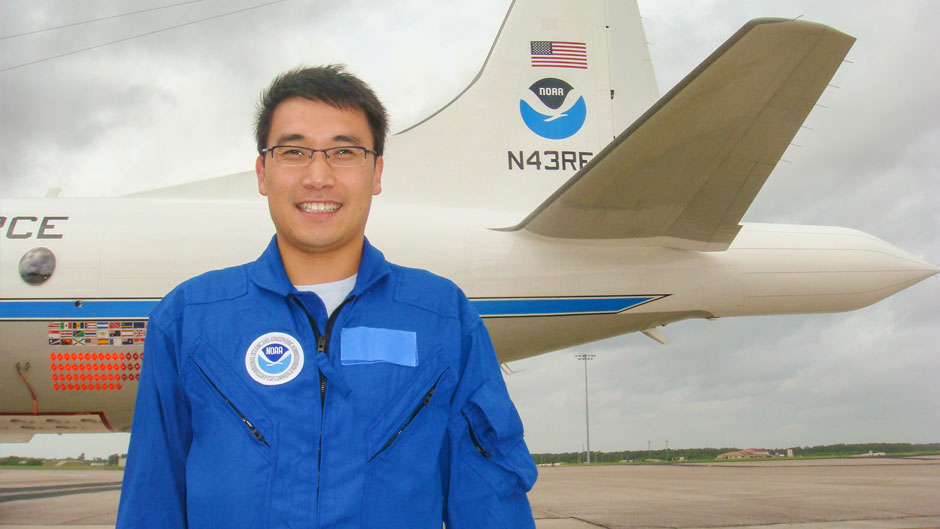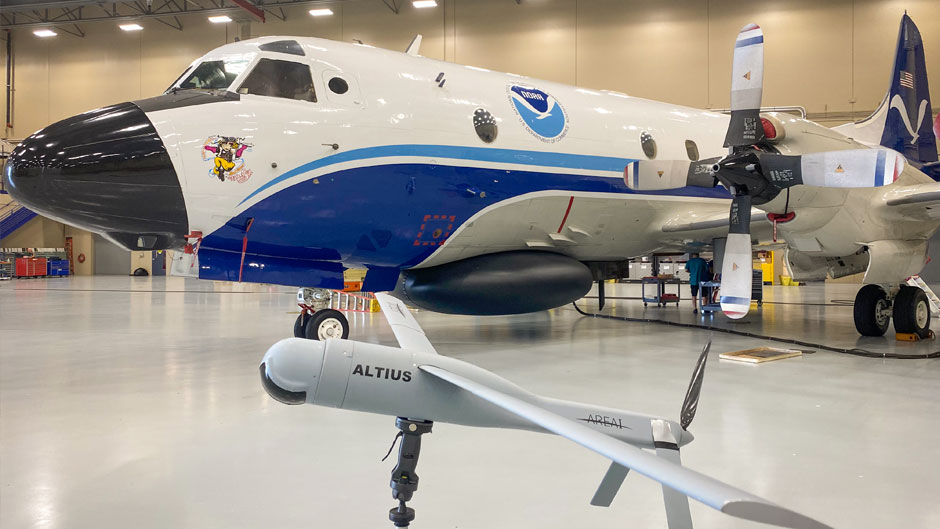University scientist deploys new drone to study hurricane intensification
SOURCE: NEWS.MIAMI.EDU
OCT 07, 2022

CIMAS meteorologist Jun Zhang and collaborators were able to send an Altius drone into the eyewall of Category 4 Hurricane Ian. The information they gathered could help improve hurricane intensity forecasts.
Meteorologist Jun Zhang will not forget the extreme turbulence he experienced—and millions watched—aboard a hurricane hunter plane recently.
But he will likely remember the flight into Hurricane Ian for a different reason.
It was the first time that Zhang, a hurricane scientist at the University of Miami Cooperative Institute for Marine and Atmospheric Studies (CIMAS), was able to deploy a state-of-the-art drone that flew into the massive storm’s eyewall.
The small, but hearty Area-I Altius 600, was released from a WP-3D Orion Hurricane Hunter aircraft on Wednesday, Sept. 28, while Zhang was on board. It flew around inside Ian’s powerful Category 4 core for close to two hours, which allowed Zhang and his collaborators to collect new data that may help them unravel the rapid intensification process of major hurricanes.
“The Altius was able to measure around 216 miles per hour winds at an altitude of 2,150 feet, which is a record for a small uncrewed aircraft deployed in a hurricane,” said Zhang, who deployed the 27-pound drone as the lead investigator on a research study funded by the National Oceanic and Atmospheric Administration's (NOAA) Weather Program Office. “It flew along the eyewall for a long time, so that was quite an achievement. I was worried it might not work; but this was pretty successful and hopefully, it can help us to improve hurricane forecasts in real time.”
Zhang is part of a larger group testing many different uncrewed aircraft systems, including Saildrones, to collect data from hurricanes, an effort led by NOAA’s Atlantic Oceanographic Meteorological Laboratory (AOML).
But Zhang is intrigued to see what the Altius can tell him about how hurricanes strengthen. His research team—which includes Joe Cione, AOML’s lead meteorologist for new technologies and Josh Wadler, an alumnus of the Rosenstiel School of Marine, Atmospheric, and Earth Science, and assistant professor of applied aviation sciences at Embry-Riddle Aeronautical University—tested a variety of different drones throughout the past two years. And when Hurricane Ian transformed from a storm with 120 mile-per-hour winds to 155-mile-per-hour winds in a few hours, they found a window of opportunity.
“We almost tried it in Hurricane Fiona, but then we thought we missed our chance until Ian came along and turned into a major storm,” said Zhang, who deployed Altius on the same day that Ian made landfall in Lee County, Florida.
NOAA’s crewed hurricane hunter planes contain dozens of sensors to gather data about storms, and scientists and meteorologists on board typically release dropsondes (radio transmitters dropped by parachute into the ocean) from the aircraft’s belly to measure wind speeds, pressure, temperature, and humidity to guide forecasts. But the planes can’t stay in the low-level eyewall and move to different altitudes within it because of safety constraints. This is the advantage of the Altius, according to Zhang. Being able to get within 500 feet above the ocean’s surface, yet remain in the eyewall region of the storm, could offer critical information to illuminate the hurricane intensity, he pointed out.

“This drone can collect data on fluctuations in humidity and heat close to the water surface, which are key because that is where the energy is generated for hurricanes. And no one has been able to do this type of data collection in the hurricane eyewall,” said Zhang, who has flown into 40 different hurricanes during the past 14 years as part of NOAA’s Hurricane Field program. “For understanding of intensity change, you have to measure the low-level energy fluctuation, and we hope we can do that using the Altius,” he added.
“The rapid intensification of hurricanes is occurring more in recent years, and it is one that hurricane researchers want to better understand,” said Ben Kirtman, professor of atmospheric sciences at the Rosenstiel School, as well as director of CIMAS. Kirtman and other meteorologists developed a tool called the North American Multi-Model Ensemble (NMME), which provides monthly-to-seasonal global forecasts that incorporate climate change. The NMME forecasts are used by NOAA and the U.S. Air Force for planning.
“Over the last five to 10 years, we have made lots of progress and improvements in storm tracks, but the hurricane intensification process has been a big struggle for meteorologists, and we haven’t done a great job of improving the intensification forecasts,” Kirtman said. “But it’s hard to figure out how to predict and simulate intensification if you don’t have the data for it, so this is one of the first times that we’re getting really great data in places we don’t normally get it. This information could be a sea change in terms of how we represent hurricane intensity.”
An alumnus of the Rosenstiel School, Zhang earned his doctoral degree in applied marine physics in 2007 and immediately joined CIMAS. He began working with the AOML Hurricane Research Division as a postdoctoral fellow; and then in 2009, Zhang transitioned to a position as a CIMAS hurricane scientist. He continues to collaborate closely with scientists at AOML and is one of seven CIMAS scientists who are part of NOAA’s 2022 Hurricane Field program. For Hurricane Ian alone, Zhang flew six missions.
As part of his research, the scientist uses data from the hurricane hunter planes to help build mathematical models that can more accurately pinpoint hurricane intensity. From 2012 to 2017, he worked on a project that incorporated data from crewed hurricane hunter planes to improve hurricane intensity forecasts. That information has helped prediction be about 10 percent more accurate today. For that work, Zhang said he won the 2020 Banner I. Miller Award from the American Meteorological Society.
Kirtman said he is glad that Zhang is a part of CIMAS and the University community, since his research will likely help inform anyone in the path of future storms.
“This information will ultimately be used to improve NOAA’s operational models and operational forecasts, and that’s fantastic,” Kirtman said. “Every scientist wants to be able to say the science they are doing is improving people’s lives, and I think it’s pretty reasonable for Jun to feel that he is on the cusp of doing something that is improving people’s lives by getting better forecasts in hurricane intensity.”
LATEST NEWS
WHAT'S TRENDING


Data Science
5 Imaginative Data Science Projects That Can Make Your Portfolio Stand Out
OCT 05, 2022

Coventry University expert explains what Amazon drone deliveries means for jobs and the price of a package
SOURCE: HTTPS://WWW.COVENTRYTELEGRAPH.NET/
NOV 02, 2023
This New Autonomous Drone for Cops Can Track You in the Dark
SOURCE: HTTPS://WWW.WIRED.COM/
SEP 26, 2023
Tamil Nadu government approves farm mechanisation subsidy for Garuda Aerospace drones
SOURCE: HTTPS://AGRICULTUREPOST.COM/
SEP 25, 2023
The Future Of Biomedical Transport: Drones At The Service Of Health
SOURCE: HTTPS://WWW.EMERGENCY-LIVE.COM/
AUG 25, 2023
Groundbreaking Drone Flights with Radiation Detection Pave the Way for Improved Safety on Nuclear Sites
SOURCE: HTTPS://DRONELIFE.COM/
AUG 11, 2023
Drone with sticky patches studies biodiversity by bumping into trees
SOURCE: HTTPS://WWW.NEWSCIENTIST.COM/
JUL 13, 2023




